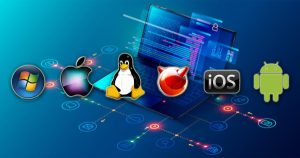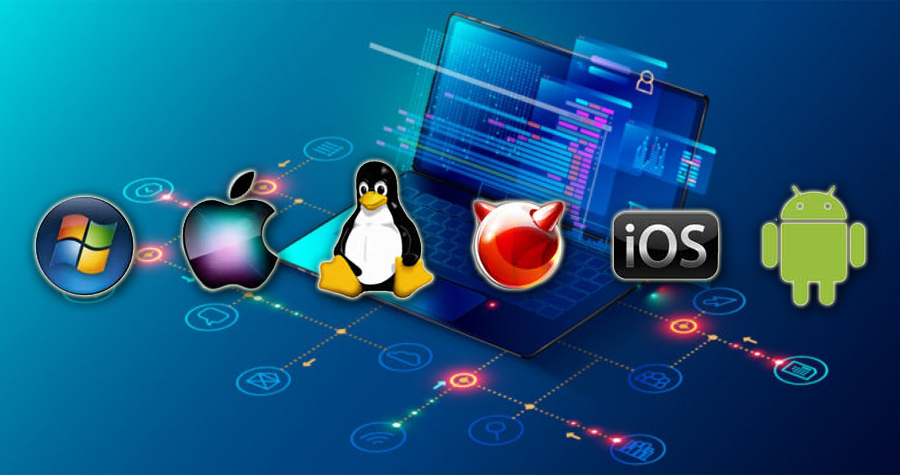operating system in 2025.
An operating system (OS) is the program that, after being initially loaded into the computer by a boot program, manages all the other application programs in a computer. The application programs use the OS by requesting services through a defined application program interface (API). In addition, users can interact directly with the operating system through a user interface (UI), such as a command-line interface (CLI) or a graphical user interface (GUI).
Without an operating system, a computer is just a box full of hardware parts — it wouldn’t know how to function or respond to commands.
Functions of an operating system in 2025
1. Process management: Process Management for a single-tasking or batch processing system is easy, as only one process is active at a time. With multiple processes (multiprogramming or multitasking) being active, process management becomes complex as a CPU needs to be efficiently utilized by multiple processes. Multiple active processes may share resources like memory and may communicate with each other. This further makes things complex as an Operating System has to do process synchronization.
Please remember that the main advantages of having multiprogramming are system responsiveness and better CPU utilization. We can run multiple processes in an interleaved manner on a single CPU. For example, when the current process is getting busy with IO, we assign the CPU to some other process.
. process creation and termination: Process creation involves creating a Process ID, setting up Process Control Block, etc. A process can be terminated either by the operating system or by the parent process. Process termination involves clearing all resources allocated to it.
. CPU Scheduling: In a multiprogramming system, multiple processes need to get the CPU. It is the job of Operating System to ensure smooth and efficient execution of multiple processes.
. Deadlock Handling: Making sure that the system does not reach a state where two or more processes cannot proceed due to cyclic dependency on each other
. Inter-Process Communication: The Operating System provides facilities such as shared memory and message passing for cooperating processes to communicate.
. process synchronization: Process Synchronization is the coordination of the execution of multiple processes in a multiprogramming system to ensure that they access shared resources (like memory) in a controlled and predictable manner.
2. Memory Management: Manages the computer’s memory (RAM), keeping track of each byte and allocating/deallocating memory as needed.
impoartance of memory management:
. allocate and de-allocate memory before and after process execution.
. to keep track of used memory space by processes
. to minimize fragmentation issue.
. to proper utilization of main memory
. to maintain data integrity while executing of process.

3. files system management:
A file system is a method an operating system uses to store, organize, and manage files and directories on a storage device. Some common types of file systems include:
.FAT (File Allocation Table): An older file system used by older versions of Windows and other operating systems.
.NTFS (New Technology File System): A modern file system used by Windows. It supports features such as file and folder permissions, compression, and encryption.
.ext. (Extended File System): A file system commonly used on Linux and Unix-based operating systems.
.HFS (Hierarchical File System): A file system used by macOS.
.APFS (Apple File System): A new file system introduced by Apple for their Macs and iOS devices.
A file is a collection of related information that is recorded on secondary storage. Or file is a collection of logically related entities. From the user’s perspective, a file is the smallest allotment of logical secondary storage.
4. Device management
device management is the managing and coordinating hardware devices, ensuring they function properly and interact correctly with the system.
Functions of Device Management
.Keeps track of all devices and the program that is responsible for performing this is called the I/O controller.
.Monitoring the status of each device such as storage drivers, printers, and other peripheral devices.
.Enforcing preset policies and making a decision on which process gets the device when and for how long.
.Allocates and deallocates the device efficiently
Types of Device Management
There are three main types of devices:
.Boot Device: It stores information in a fixed-size block, each one with its own address. Example, disks.
.Character Device: It delivers or accepts a stream of characters. the individual .characters are not addressable. For example, printers, keyboards etc.
.Network Device: It is for transmitting data packets.
5. Security and Access Control.
Protects data and system resources through authentication and permissions.
6. user interface : Provides an interface (command-line or graphical) for users to interact with the system.
Types of Operating Systems:
Batch Operating System – Executes batches of jobs with minimal interaction (e.g., early mainframe systems).
Time-Sharing OS – Allows multiple users to use the system simultaneously (e.g., Unix).
Distributed OS – Manages a group of separate computers and makes them appear to be a single system.
Embedded OS – Designed for embedded systems like smart TVs, routers, and medical devices.
Mobile OS – Optimized for mobile devices (e.g., Android, iOS).
Real-Time OS (RTOS) – Provides immediate processing for time-sensitive tasks (e.g., used in robotics).
